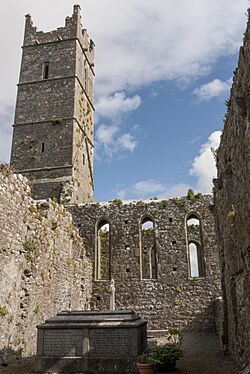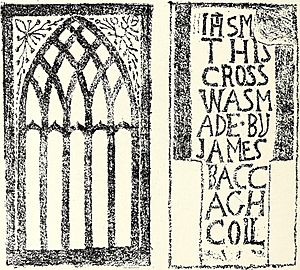Claregalway Friary facts for kids
| Mainistir Bhaile Chláir | |
 |
|
| Monastery information | |
|---|---|
| Order | Franciscans |
| Established | c.1240 |
| People | |
| Founder(s) | John de Cogan |
| Architecture | |
| Status | Inactive |
| Site | |
| Location | Claregalway, County Galway, Ireland |
| Public access | Yes |
| Official name | Claregalway Abbey |
| Reference no. | 165 |
The Claregalway Friary (Irish: Mainistir Bhaile Chláir) is a ruined medieval Franciscan abbey in Claregalway, County Galway, Ireland.
An abbey is a type of monastery where monks or nuns live. This one was home to Franciscan friars.
The abbey has a church shaped like a cross, but it's missing one arm. It also has a tall bell tower, about 24 meters (80 feet) high. The living areas and a cloister (an open courtyard) are next to the church.
Contents
History of Claregalway Friary
Claregalway Friary was started around the year 1240. We know for sure it was built before 1250. Some people thought John de Cogan II founded it. But it was actually his father, John de Cogan I, who began the friary.
In 1326, John Magnus de Cogan (John de Cogan III) said he was the founder. This likely means he was a big supporter of the monastery. Or perhaps he made it much larger. The Franciscan monks lived there with the help of the de Cogan family. In 1327, Magnus de Cogan gave them the buildings and land. In return, the monks had to give a rose to de Cogan and his family every year. This was on the day we celebrate the birth of John the Baptist.
The friary was updated in the 1400s. During this time, the tall tower and the east window of the main church area were added.
Challenges for the Friary
The community of monks did well until the mid-1500s. This was when the English Reformation caused big changes for Catholic churches in Ireland. From then on, the monks at Claregalway found it hard to keep the abbey going. They faced many political and money problems.
On July 11, 1538, soldiers led by Lord Leonard Gray attacked and robbed the abbey. This happened while they were marching to Galway. In 1570, Queen Elizabeth I gave the monastery to Sir Richard de Burgo. Around 1589, the monastery buildings were turned into a barracks. A barracks is a place where soldiers live. This was done by the English governor, Sir Richard Bingham.
Later, when King James was in charge, the property was given to the Earl of Clanrickarde. By 1641, the Franciscans were back at the abbey. But the buildings were in bad shape, and the monks didn't have money to fix them.
The Friary in Later Years
In 1731, Edward Synge, an Anglican archbishop, wrote that "there is a friary in Claregalway, where three at least are always resident." This means at least three monks lived there all the time. The local sheriff, Stratford Eyre, said in 1732 that the monks "lived close" to the abbey.
Church records show that about 220 religious people were part of the community in 1766. But this number dropped to about 150 by 1782. A French visitor, Coquebert de Montbret, wrote in 1791 that "the monks are settling down among the ruins."
The number of monks kept getting smaller. By 1838, there were only two members left. Old newspaper records show that the last two monks left for a bigger monastery in Galway in November 1847. For some years after the monastery closed, monks from Galway still visited. They would come to celebrate Mass and hear confessions on special days. But these visits stopped by 1860.
In 1892, a person named Lord Clanmorris gave the property to the Commissioner of Public Works. This was done to protect old buildings.
Architecture of the Church
The church's main area, called the nave, had an aisle added to it. This aisle has four pointed archways. The round pillars holding up the arches are simple. They have plain tops, called capitals.
Notable Burials
Some important people were buried at Claregalway Friary:
- Muiris Ó Fithcheallaigh: An Irish Franciscan theologian and Archbishop of Tuam. He lived from about 1460 to 1513.
- Tomás Ó Maolalaidh: A Bishop of Clonmacnoise (around 1509-1514) and later Archbishop of Tuam (1514–1536).
See also
- List of abbeys and priories in Ireland (County Galway)



